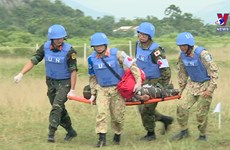HCM City moves to lower HIV/AIDS numbers
Anti-retroviral therapy treatment will be expanded, and prevention and
harm-reduction measures increased to reduce the number of HIV/AIDS cases
in Ho Chi Minh City, experts have said.
Anti-retroviral therapy treatment will be expanded, and prevention and
harm-reduction measures increased to reduce the number of HIV/AIDS cases
in Ho Chi Minh City, experts have said.
Early anti-retroviral (ARV) treatment will be launched next year, Tieu Thi Thu Van, head of the administrative office of Ho Chi Minh City's AIDS Committee told a seminar held in the southern hub on December 10.
The early treatment will be offered in all medical units, including private ones, to 2,500 patients, or 20 percent of the total number of HIV/AIDS patients, by the end of 2015.
The aim is to have early ARV treatment to cover 90 percent of infected persons by 2025 in order to eliminate all cases in the 2025-30 period.
The number of ARV patients is expected to reach 26,000 by 2015, from an estimated 23,000 patients in 2013.
By 2015, the average number of patients per outpatient clinic is expected to be between 600 and 1,000.
This year, at least 5,200 patients were newly registered at more than 30 outpatient clinics and nearly 3,000 patients were given ARV treatment.
HIV/AIDS prevention in Ho Chi Minh City has received 90-93 percent of its financial support from international organisations.
However, such support is expected to fall, but the need is still high, which poses challenges for HIV/AIDS-prevention activities in the city, she said.
Le Truong Giang, chairman of the Ho Chi Minh City Public Health Association, said that funding for HIV/AIDS prevention programmes would rely on the State budget, health insurance and private funds, as international aid is falling sharply.
Funding resources should be used efficiently, Giang said, adding that funding from the Government and international organisations must be focused on activities for target groups, such as pregnant women, high-risk people and patients infected with hepatitis and tuberculosis.
AIDS activities for other targetted groups will be assisted by private sources of support.
"Expanding HIV counseling and testing to detect HIV-infected cases early is the first action to end the spread of the disease here," Giang said.
HIV-infected people "live with HIV, but die by co-infection", he said, adding that harm-reduction intervention should be targetted at those people with the highest behavioral risk.
Co-infections can come with HIV transmission (via blood, sexual relations or from mother to fetus). It is often seen with hepatitis B and hepatitis C, which evolve quietly and thus get less attention compared with HIV, he said.-VNA
Early anti-retroviral (ARV) treatment will be launched next year, Tieu Thi Thu Van, head of the administrative office of Ho Chi Minh City's AIDS Committee told a seminar held in the southern hub on December 10.
The early treatment will be offered in all medical units, including private ones, to 2,500 patients, or 20 percent of the total number of HIV/AIDS patients, by the end of 2015.
The aim is to have early ARV treatment to cover 90 percent of infected persons by 2025 in order to eliminate all cases in the 2025-30 period.
The number of ARV patients is expected to reach 26,000 by 2015, from an estimated 23,000 patients in 2013.
By 2015, the average number of patients per outpatient clinic is expected to be between 600 and 1,000.
This year, at least 5,200 patients were newly registered at more than 30 outpatient clinics and nearly 3,000 patients were given ARV treatment.
HIV/AIDS prevention in Ho Chi Minh City has received 90-93 percent of its financial support from international organisations.
However, such support is expected to fall, but the need is still high, which poses challenges for HIV/AIDS-prevention activities in the city, she said.
Le Truong Giang, chairman of the Ho Chi Minh City Public Health Association, said that funding for HIV/AIDS prevention programmes would rely on the State budget, health insurance and private funds, as international aid is falling sharply.
Funding resources should be used efficiently, Giang said, adding that funding from the Government and international organisations must be focused on activities for target groups, such as pregnant women, high-risk people and patients infected with hepatitis and tuberculosis.
AIDS activities for other targetted groups will be assisted by private sources of support.
"Expanding HIV counseling and testing to detect HIV-infected cases early is the first action to end the spread of the disease here," Giang said.
HIV-infected people "live with HIV, but die by co-infection", he said, adding that harm-reduction intervention should be targetted at those people with the highest behavioral risk.
Co-infections can come with HIV transmission (via blood, sexual relations or from mother to fetus). It is often seen with hepatitis B and hepatitis C, which evolve quietly and thus get less attention compared with HIV, he said.-VNA











